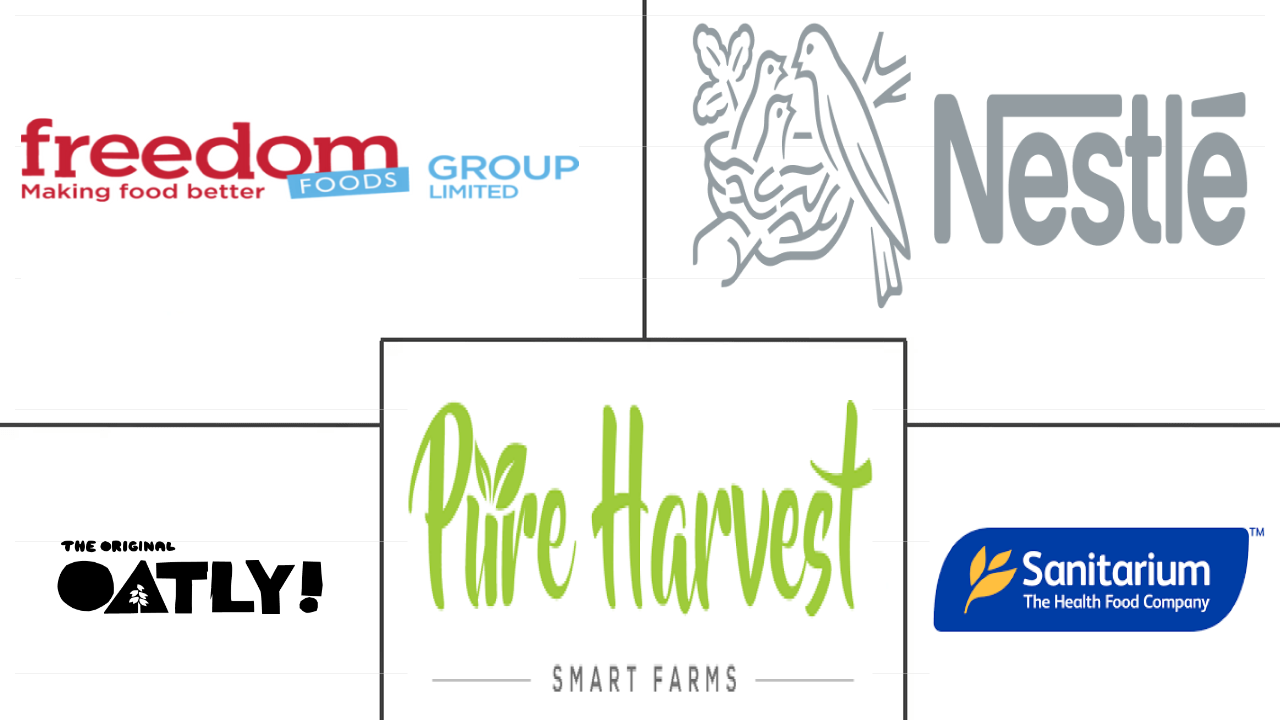Market Size of asia-pacific oat milk Industry
|
|
Study Period | 2017 - 2029 |
|
|
Market Size (2024) | USD 394 Million |
|
|
Market Size (2029) | USD 700.8 Million |
|
|
Largest Share by Distribution Channel | Off-Trade |
|
|
CAGR (2024 - 2029) | 12.21 % |
|
|
Largest Share by Country | Australia |
Major Players |
||

|
||
|
*Disclaimer: Major Players sorted in no particular order |
Asia-Pacific Oat Milk Market Analysis
The Asia-Pacific Oat Milk Market size is estimated at 394 million USD in 2024, and is expected to reach 700.8 million USD by 2029, growing at a CAGR of 12.21% during the forecast period (2024-2029).
394 Million
Market Size in 2024 (USD)
700.8 Million
Market Size in 2029 (USD)
10.23 %
CAGR (2017-2023)
12.21 %
CAGR (2024-2029)
Largest Market by Distribution Channel
94.62 %
value share, Off-Trade, 2023
The product assortment and shelf space in off-trade retail channels is allowing consumers to compare the products, which has emerged to be one of the major factor driving segmental growth.
Largest Market by Country
20.12 %
value share, Australia, 2023
The number of beverage sales using plant-based milk has increased massively in Australia with socially conscious and health-driven café customers driving segmental growth.
Fastest-growing Market by Distribution Channel
12.46 %
Projected CAGR, Off-Trade, 2024-2029
The ease of product comparibility enabling them to read the labels which is provoking them to make smarter choices in the market is largely driving the segmental growth.
Fastest-growing Market by Country
20.40 %
Projected CAGR, China, 2024-2029
The health beneficial factors of oat milk along with its similarity in technical aspects to dairy is largely captivating the consumption of oat milk in China through coffe shops and others.
Leading Market Player
23.68 %
market share, Oatly Group AB, 2022

The Oatly Group AB's broad distribution network in retail and foodservice sectors supports its largest market share through partnerships with industrial giants.
Wide presence of popular chains is supporting the market growth
- The off-trade channel dominates oat milk sales in Asia-Pacific compared to other distribution channels. Supermarkets and hypermarkets accounted for most of the share of oat milk sales in 2022, i.e., 57.8%. This growth was due to the availability of international and local brands at these stores.
- Convenience stores are the second most widely preferred off-trade retail channel for oat milk sales. The sales value of oat milk through convenience stores is anticipated to grow by 31.5% in 2025 compared to 2022. Top convenience stores like Easy Joy, Meiyijia, 7-Eleven Inc., and Lawson are offering dairy alternatives, such as oat milk, with annual memberships and discounts on bulk purchases to attract consumers. This trend is expected to drive oat milk sales during the forecast period. As of 2021, Easy Joy was the largest convenience store, with more than 27,600 outlets in China. Meiyijia and 7-Eleven stood second and third with 22,394 and 20,988 stores, respectively.
- There is an increasing demand for oat milk drinks from foodservice channels, further boosting the market's growth. Many coffee chains and restaurants in the region offer oat milk on their menus. Oat milk sales from the on-trade channel grew by 11.3% from 2020 to 2022, attributed to consumers preferring dairy alternatives, such as oat milk, away from home, whether while dining out at a restaurant or ordering takeout. As of 2021, Indian consumers ate out nearly seven times a month, and over 80% of the respondents stated that they would prefer affordable casual dining options and fast-service restaurants.
China holds significant share due to growing increases consumers inclination towards oat milk consumption
- With the growing adoption of Western culture, there is a significant growth in the adoption of flexitarian and vegan lifestyles. In 2021, around 2.5 million people in South Korea followed a vegan diet, which increased significantly in the past 2-3 years. This growing trend is a major factor driving the consumption of oat milk..
- Rising awareness of health and wellness and the growing health problems among consumers, such as heart diseases, high blood pressure, diabetes, and asthma, are driving the consumption of plant-based dairy alternatives, including oat milk, across the region. Many lactose-intolerant consumers do not consume milk or milk products, leading to increased demand for oat milk. The sales value of oat milk in the Asia-Pacific region is anticipated to grow by 10.82% compared to 2021.
- Lactose intolerance is another growing concern in Asian countries, particularly in East Asia, where nearly more than 70% of the population has lactose intolerance. Cow milk allergy is one of the common food allergies in young children. Many Japanese consumers are also lactose-intolerant and do not consume milk or milk products. As of 2022, around 1 in 50 babies and young children in Australia showed signs of an allergy to cow's milk. Therefore, oat milk demand is increasing gradually across the region.
- Consumers in the region are becoming increasingly aware of their nutritional choices. Owing to their busy lifestyles, their purchasing decision depends on a product's nutritional value, thus driving the demand for plant-based milk in the region. Consumers, especially those allergic to dairy milk, are keen on consuming oat milk as a substitute.
Asia-Pacific Oat Milk Industry Segmentation
Off-Trade, On-Trade are covered as segments by Distribution Channel. Australia, China, India, Indonesia, Japan, Malaysia, New Zealand, Pakistan, South Korea are covered as segments by Country.
- The off-trade channel dominates oat milk sales in Asia-Pacific compared to other distribution channels. Supermarkets and hypermarkets accounted for most of the share of oat milk sales in 2022, i.e., 57.8%. This growth was due to the availability of international and local brands at these stores.
- Convenience stores are the second most widely preferred off-trade retail channel for oat milk sales. The sales value of oat milk through convenience stores is anticipated to grow by 31.5% in 2025 compared to 2022. Top convenience stores like Easy Joy, Meiyijia, 7-Eleven Inc., and Lawson are offering dairy alternatives, such as oat milk, with annual memberships and discounts on bulk purchases to attract consumers. This trend is expected to drive oat milk sales during the forecast period. As of 2021, Easy Joy was the largest convenience store, with more than 27,600 outlets in China. Meiyijia and 7-Eleven stood second and third with 22,394 and 20,988 stores, respectively.
- There is an increasing demand for oat milk drinks from foodservice channels, further boosting the market's growth. Many coffee chains and restaurants in the region offer oat milk on their menus. Oat milk sales from the on-trade channel grew by 11.3% from 2020 to 2022, attributed to consumers preferring dairy alternatives, such as oat milk, away from home, whether while dining out at a restaurant or ordering takeout. As of 2021, Indian consumers ate out nearly seven times a month, and over 80% of the respondents stated that they would prefer affordable casual dining options and fast-service restaurants.
| Distribution Channel | |||||||||
| |||||||||
| On-Trade |
| Country | |
| Australia | |
| China | |
| India | |
| Indonesia | |
| Japan | |
| Malaysia | |
| New Zealand | |
| Pakistan | |
| South Korea | |
| Rest of Asia Pacific |
Asia-Pacific Oat Milk Market Size Summary
The Asia-Pacific oat milk market is experiencing significant growth, driven by a shift in consumer preferences towards plant-based dairy alternatives. This trend is largely influenced by the rising adoption of flexitarian and vegan lifestyles, as well as increasing awareness of health and wellness. The market is characterized by a strong demand for oat milk in both off-trade and on-trade channels, with supermarkets, hypermarkets, and convenience stores leading in sales. The availability of international and local brands in these retail outlets, along with attractive membership and discount offers, is contributing to the market's expansion. Additionally, the growing popularity of oat milk in foodservice channels, such as coffee chains and restaurants, is further boosting its consumption.
The market's growth is also supported by the increasing number of lactose-intolerant consumers and those with cow milk allergies in the region, particularly in East Asia. This has led to a rising demand for oat milk as a dairy substitute. The per capita consumption of oat milk is on the rise, driven by consumer preferences for sustainable and allergen-free ingredients. The market is fragmented, with key players like Freedom Foods Group Ltd, Nestlé SA, Oatly Group AB, PureHarvest, and Sanitarium Health and Wellbeing Company playing significant roles. Recent expansions and product launches by these companies indicate a competitive landscape, with ongoing efforts to capture a larger share of the growing market.
Asia-Pacific Oat Milk Market Size - Table of Contents
-
1. MARKET SEGMENTATION (includes market size in Value in USD and Volume, Forecasts up to 2029 and analysis of growth prospects)
-
1.1 Distribution Channel
-
1.1.1 Off-Trade
-
1.1.1.1 By Sub Distribution Channels
-
1.1.1.1.1 Convenience Stores
-
1.1.1.1.2 Online Retail
-
1.1.1.1.3 Specialist Retailers
-
1.1.1.1.4 Supermarkets and Hypermarkets
-
1.1.1.1.5 Others (Warehouse clubs, gas stations, etc.)
-
-
-
1.1.2 On-Trade
-
-
1.2 Country
-
1.2.1 Australia
-
1.2.2 China
-
1.2.3 India
-
1.2.4 Indonesia
-
1.2.5 Japan
-
1.2.6 Malaysia
-
1.2.7 New Zealand
-
1.2.8 Pakistan
-
1.2.9 South Korea
-
1.2.10 Rest of Asia Pacific
-
-
Asia-Pacific Oat Milk Market Size FAQs
How big is the Asia-Pacific Oat Milk Market?
The Asia-Pacific Oat Milk Market size is expected to reach USD 393.99 million in 2024 and grow at a CAGR of 12.21% to reach USD 700.75 million by 2029.
What is the current Asia-Pacific Oat Milk Market size?
In 2024, the Asia-Pacific Oat Milk Market size is expected to reach USD 393.99 million.

